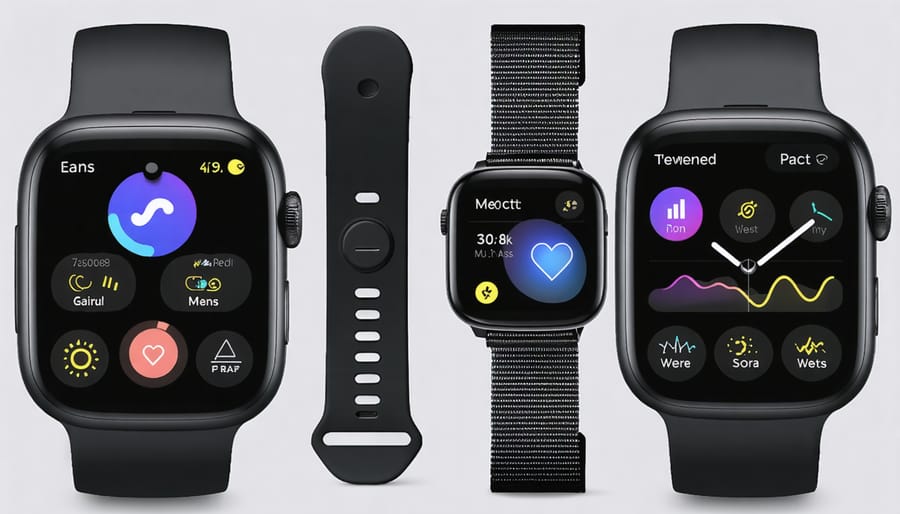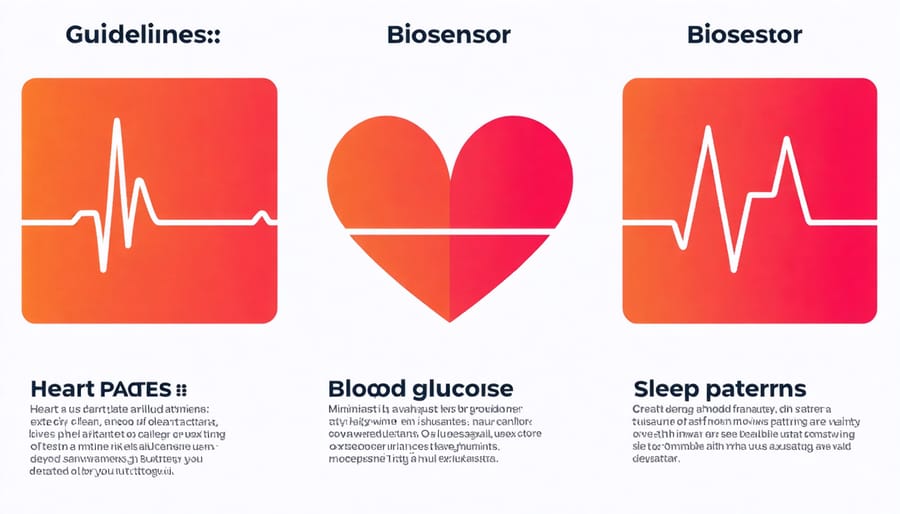Transform your health monitoring with wearable biosensors – powerful, pocket-sized devices that continuously track vital signs and provide real-time health insights. These innovative tools have revolutionized personal healthcare by detecting early warning signs of health issues before they become serious problems. From smartwatches measuring heart rate and blood oxygen levels to patch sensors monitoring blood glucose and hydration status, wearable biosensors empower you to take control of your well-being.
Recent advances in biosensor technology have made these devices more accurate, comfortable, and affordable than ever before. Whether you’re managing a chronic condition, optimizing your fitness routine, or simply staying proactive about your health, these smart devices offer personalized data that helps you make informed decisions about your lifestyle and medical care.
Join thousands of Albertans who are already using wearable biosensors to prevent health complications and maintain their independence. With continuous monitoring and instant alerts, you’ll have peace of mind knowing that your health is being tracked around the clock.
How Wearable Biosensors Are Changing Healthcare
From Fitness Trackers to Life-Saving Devices
Remember those basic step counters from a few years ago? Today’s wearable technology has come a long way. Modern devices can track everything from your heart rate and sleep patterns to blood oxygen levels and stress indicators. These smart devices have transformed from simple fitness gadgets into sophisticated health monitoring tools that many Albertans rely on daily.
The latest biosensors can detect irregular heart rhythms, monitor blood sugar levels, and even predict potential health issues before they become serious. For people managing chronic conditions like diabetes or heart disease, these devices provide real-time health data that can be shared directly with healthcare providers.
Many local healthcare facilities now integrate data from these devices into patient care plans. This evolution means better preventive care and more personalized health management for everyone, whether you’re an athlete tracking performance or someone monitoring a health condition.
The best part? These tools are becoming more user-friendly and affordable, making proactive health monitoring accessible to more people in our community.

Real-Time Health Monitoring at Your Fingertips
Today’s wearable biosensors can track an impressive range of health indicators right from your wrist or other comfortable locations on your body. These devices continuously measure vital signs like heart rate, blood oxygen levels, and skin temperature, providing you with real-time insights into your health status. Many sensors also track sleep patterns, stress levels, and physical activity, creating a comprehensive picture of your daily well-being.
The data collected through remote health monitoring is automatically stored and analyzed, making it easy to spot patterns or potential concerns. Most devices connect to smartphone apps that display your health information through easy-to-understand graphs and charts. You’ll receive gentle reminders and alerts when measurements fall outside your normal range, empowering you to take proactive steps for your health.
These measurements are particularly valuable for Albertans managing chronic conditions like diabetes or heart disease, as they provide continuous feedback without the need for frequent clinic visits.

Key Health Markers You Can Track Today
Heart Health and Blood Pressure
Modern wearable biosensors make tracking your heart health easier than ever. These devices continuously monitor your heart rate and blood pressure patterns throughout the day, giving you a complete picture of your cardiovascular health. Many smart watches and fitness bands now include advanced sensors that can detect irregular heart rhythms and alert you to potential concerns before they become serious.
For Albertans managing blood pressure, these devices offer convenient at-home monitoring without the stress of clinical settings. They track trends over time, helping you and your healthcare provider make informed decisions about your treatment plan. Some devices even remind you to move around when you’ve been sitting too long or guide you through stress-reducing breathing exercises.
Remember, while these tools are valuable for daily monitoring, they work best as part of your overall heart health strategy, including regular check-ups with your healthcare provider.
Blood Sugar and Diabetes Management
Modern wearable biosensors have revolutionized diabetes management by offering continuous glucose monitoring without frequent finger pricks. These devices use tiny sensors placed under the skin to measure blood sugar levels every few minutes, sending real-time readings to your smartphone or smartwatch. Many Albertans are now using these devices to better understand their body’s response to food, exercise, and daily activities.
The latest glucose monitoring systems can predict dangerous blood sugar trends before they become serious, allowing you to take action sooner. They can also share your readings with family members or healthcare providers, creating a stronger support network for diabetes management. Some devices even integrate with insulin pumps to help regulate blood sugar levels automatically.
For those at risk of developing diabetes, these wearable monitors can help identify early warning signs and track how lifestyle changes affect blood sugar patterns.
Sleep and Stress Patterns
Modern wearable biosensors are revolutionizing how we track and understand our sleep patterns and stress levels. These devices monitor heart rate variability, sleep stages, and physical movements to provide insights into your rest quality. They can detect when you’re in light, deep, or REM sleep, helping you understand your natural sleep cycles.
For stress management, these sensors measure subtle changes in your body’s responses throughout the day. They track indicators like skin temperature, sweating patterns, and heart rhythm variations to identify periods of heightened stress. Many devices now offer gentle reminders to take breathing breaks or suggest stress-relief activities when they detect elevated stress levels.
By understanding these patterns, you can make informed decisions about your daily routines and develop better sleep habits. This data empowers you to take control of your mental well-being and make positive lifestyle changes.
Physical Activity and Exercise Metrics
Modern wearable biosensors excel at tracking your daily movement and exercise habits. These devices can count your steps, measure distance traveled, and monitor your heart rate during physical activities. Many also track calories burned, floors climbed, and active minutes throughout your day.
Advanced features include workout recognition, which automatically detects when you’re walking, running, cycling, or swimming. Sleep tracking is another valuable component, measuring both the duration and quality of your rest periods between activities.
Some devices now offer guided workout programs and real-time coaching, helping you maintain proper form and intensity. They can even alert you when you’ve been inactive too long, encouraging you to stay moving throughout the day.
By tracking these metrics over time, you can better understand your activity patterns and make informed decisions about your fitness goals. This data helps you build healthier habits and maintain an active lifestyle that works for you.
Making Sense of Your Health Data

Understanding Your Numbers
Making sense of health data doesn’t have to be overwhelming. Modern wearable biosensors provide personalized health insights that can help you take control of your well-being. Start by understanding your baseline numbers – these are your typical readings when you’re feeling well and going about your daily routine.
For heart rate, most adults have a resting rate between 60-100 beats per minute. Lower numbers often indicate better fitness levels. Blood oxygen levels should typically stay above 95%, while blood pressure readings are considered normal around 120/80.
Sleep tracking data can tell you about both quantity and quality. Aim for 7-9 hours of sleep, with consistent bedtime and wake-up times. Pay attention to your deep sleep periods, which should make up about 15-25% of your total sleep time.
Step counts and activity levels are personal – while 10,000 steps is a popular goal, focus on gradually increasing your current average. The key is to look for patterns and trends rather than fixating on single readings. Any significant changes from your normal patterns are worth discussing with your healthcare provider.
When to Share Data with Your Doctor
Your wearable device collects valuable health data that can enhance your medical care when shared appropriately with your healthcare provider. Consider sharing your data during regular check-ups, especially if you notice concerning patterns or significant changes in your readings.
Make it a habit to share your data when discussing specific health concerns, managing chronic conditions, or adjusting medications. For example, if you’re monitoring your blood pressure or heart rate, bringing three months of consistent readings can help your doctor make more informed decisions about your treatment plan.
Before your appointment, organize your data into easy-to-read summaries or reports – many devices offer this feature through their apps. Focus on sharing relevant information rather than overwhelming your doctor with all available data. Most importantly, alert your healthcare provider immediately if your device shows readings outside your normal range or triggers any health alerts.
Remember that while wearable data is helpful, it should complement, not replace, regular medical check-ups and professional medical advice. Your doctor can help interpret the data within the context of your overall health picture.
Choosing the Right Biosensor for You
Selecting the right biosensor can feel overwhelming with so many options available, but focusing on your specific health needs will help narrow down the choices. Start by identifying your primary health concerns – whether it’s monitoring heart rate, blood pressure, blood sugar, or activity levels.
For those managing heart conditions, devices with ECG capabilities and continuous heart rate monitoring should be your priority. If you’re dealing with diabetes, look for sensors that offer non-invasive glucose monitoring or easy integration with your existing glucose monitor.
Consider your lifestyle and comfort preferences. Are you active and need something water-resistant? Do you prefer a watch-style device, or would a small patch sensor work better? Battery life is another crucial factor – some devices need daily charging while others can last weeks.
Your budget matters too. While high-end devices offer more features, many affordable options provide reliable basic monitoring. Remember that some health insurance providers in Alberta offer coverage or rebates for certain medical-grade biosensors.
Think about data sharing capabilities. If you want to share readings with your healthcare provider, ensure the device can export data in a format they can use. Many local clinics in Alberta now accept data from popular biosensor brands.
Don’t forget about user-friendliness. The best biosensor is one you’ll actually use consistently. Look for devices with clear displays, intuitive interfaces, and companion apps that make sense to you. Many retailers offer trial periods – take advantage of these to ensure the device meets your needs before making a long-term commitment.
Wearable biosensors have revolutionized the way we monitor and manage our health, offering unprecedented access to real-time health data right at our fingertips. These innovative devices have proven invaluable for both individuals managing chronic conditions and those taking proactive steps toward better health. By providing continuous monitoring of vital signs, activity levels, and various health markers, they empower us to make informed decisions about our well-being.
Looking ahead, the potential for wearable biosensors continues to expand. Advances in technology are paving the way for even more sophisticated monitoring capabilities, including early detection of health issues and improved management of chronic conditions. Here in Alberta, these devices are becoming increasingly integrated into our healthcare system, offering new opportunities for remote patient monitoring and preventive care.
As these technologies become more accessible and user-friendly, they’ll play an even greater role in helping us maintain our health. Whether you’re managing diabetes, monitoring heart health, or simply staying on top of your fitness goals, wearable biosensors offer a practical, effective way to take control of your health journey. By embracing these tools today, we’re stepping into a future where personalized healthcare is not just a possibility, but a reality.

